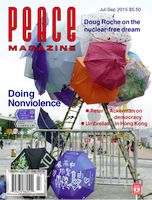
Peace Magazine Jul-Sep 2015, page 19. Some rights reserved.
Search for other articles by Dale Dewar here
Search for other articles by Bill Curry here
Up to three hundred activists, Indigenous people, researchers and academics from around the world convened April 14-16 in Quebec City for the World Uranium Symposium.
Sponsors and supporters came from a broad spectrum, including national and international physician organizations, First Nations of Québec, environmental activists, and people involved in the peace movement.
Opening with acknowledgement of the Huron-Wendat land on which we met, we were welcomed by Konrad Sioui, hereditary Grand Chief, who described historic and current conflicts between Indigenous and colonial world views and the resulting response to exportation. Matthew Coon Come, Grand Chief of the Grand Council of the Crees of Québec and Labrador, described his peoples’ opposition to uranium exploration and spoke of a culture founded on circular webs of life. Naoto Kan—who was Prime Minister of Japan at the time of the Fukushima catastrophe—connected uranium that is mined to the bombs dropped on Hiroshima and Nagasaki and exhorted the audience to “leave uranium in the ground.”
The conference provided the opportunity to meet such notables as Dr. Ian Fairlie, a former adviser to the UK government on radiological risks of the nuclear industry; Mariette Liefferink, South African whistleblower who now directs the Federation for a Sustainable Environment; and Dr. Helen Caldicott.
The Canadian Nuclear Safety Commission and the Nuclear Waste Management Organization were invited to present workshops but declined to do so.
During the conference, and much to the dismay of attendees, the Canadian government signed a uranium trade deal with India, an NPT non-signatory with an appalling human rights and environmental record. Participants launched a prompt condemnation.
With the Nuclear Non Proliferation Treaty review conference about to take place in New York (see Doug Roche’s article, this issue), the symposium’s presentations by the International Campaign to Abolish Nuclear Weapons (ICAN) were timely.
The Symposium celebrated several cultural events, including the Uranium Film Festival. Québec cultural icon Gilles Vigneault sang his new song, “Uranium,” bringing the audience to its feet in thunderous applause.
Youth Grand Chief Joshua Iserhoff, Cree Nation of Mistissini, spoke of the determination of young people who walked 800km from their community to Quebec City to oppose uranium mining.
The planning committee intended for the conference to produce a declaration that addressed issues of peace, sustainable development, environmental protection, and justice, especially for First Nations peoples. At the close of each day, a plenary received reports and created summary statements, which were integrated in successive drafts.
The Symposium was a meeting place for activists from around the world. People found that expertise from Europe could be used by the Committee for Future Generations from Northern Saskatchewan; the leader of Greenland’s Inuit Ataqatigiit Party found help to renew her position against uranium mining; the Mongolian representative heard both of successes in Québec and severe repression in Cameroon. Canadians bonded with one another and with international participants.
A conference is planned in November 2015 in Johannesburg to support African anti-nuclear movements.
The Declaration is online, and can be quoted to strengthen all non-nuclear positions, and is still available for signatures at www.uranium2015.com.
Many participants, believing a ban on uranium mining in Québec could become a worldwide ban, have begun work on such a campaign.
Dale Dewar MD is former executive director, Physicians for Global Survival. Bill Curry is a Saskatchewan peace activist.

Peace Magazine Jul-Sep 2015, page 19. Some rights reserved.
Search for other articles by Dale Dewar here
Search for other articles by Bill Curry here